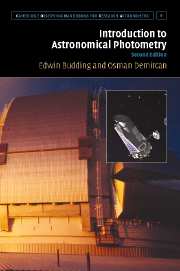Book contents
- Frontmatter
- Contents
- Preface to first edition
- Preface to second edition
- 1 Overview
- 2 Introduction
- 3 Underlying essentials
- 4 Themes of astronomical photometry
- 5 Practicalities
- 6 Procedures
- 7 Basic light curve analysis
- 8 Period changes in variable stars
- 9 Close binary systems
- 10 Spotted stars
- 11 Pulsating stars
- Appendix
- Author index
- Subject index
1 - Overview
Published online by Cambridge University Press: 13 August 2009
- Frontmatter
- Contents
- Preface to first edition
- Preface to second edition
- 1 Overview
- 2 Introduction
- 3 Underlying essentials
- 4 Themes of astronomical photometry
- 5 Practicalities
- 6 Procedures
- 7 Basic light curve analysis
- 8 Period changes in variable stars
- 9 Close binary systems
- 10 Spotted stars
- 11 Pulsating stars
- Appendix
- Author index
- Subject index
Summary
Scope of the subject
This book is aimed at laying groundwork for the purposes and methods of astronomical photometry. This is a large subject with a large range of connections. In the historical aspect, for example, we retain contact with the earliest known systematic cataloguer of the sky, at least in Western sources, i.e. Hipparchos of Nicea (∽160–127 BCE): the ‘father of astronomy’, for his magnitude arrangements are still in use, though admittedly in a much refined form. A special interest attaches to this very long time baseline, and a worthy challenge exists in getting a clearer view of early records and procedures.
Photometry has points of contact with, or merges into, other fields of observational astronomy, though different words are used to demarcate particular specialities. Radio-, infrared-, X-ray-astronomy, and so on, often concern measurement and comparison procedures that parallel the historically well-known optical domain. Spectrophotometry, as another instance, extends and particularizes information about the detailed distribution of radiated energy with wavelength, involving studies and techniques for a higher spectral resolution than would apply to photometry in general. Astrometry and stellar photometry form limiting cases of the photometry of extended objects. Since stars are, for the most part, below instrumental resolution, a sharp separation is made between positional and radiative flux data. But this distinction seems artificial on close examination.
- Type
- Chapter
- Information
- Introduction to Astronomical Photometry , pp. 1 - 10Publisher: Cambridge University PressPrint publication year: 2007

